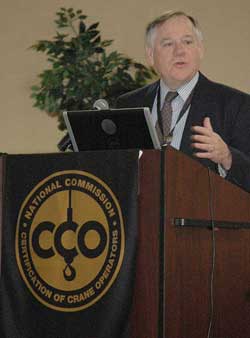June 2012 - Nearly 70 representatives from all sectors of industry from across the country attended the 32nd Biannual Meeting of the National Commission for the Certification of Crane Operators (NCCCO) at the Maritime Institute of Technology near Baltimore, MD, in April. The event comprised three days of committee meetings followed by the full Commission meeting on the last day.
Among updates presented to the Commission were current development efforts on three new CCO certification programs: for digger derrick operators, for service/mechanic truck operators, and for lift directors. The service/mechanics truck program is being developed within the existing mobile crane operator program.
“OSHA Subpart CC has brought in several different industry sectors that use cranes in a different way than construction cranes, notably delivery applications of pre-cast concrete materials, propane tanks, and monuments,” said Joel Oliva, NCCCO Manager of Test Development. “A dedicated service/mechanics truck boom operator certification program will more directly address the characteristics of how these machines are operated.”
The new digger derrick operator certification will be ready to launch in late summer, followed by the lift director program by year-end.
Committee meetings were sponsored by Morrow Equipment Company LLC, Salem, OR; the Crosby Group, Tulsa, OK; and TNT Crane and Rigging, Houston, TX. The full Commission meeting was sponsored by CEOP Training (Centro de Entrenamiento de Operadores Profesionales Ltda.) based in Vitacura, Chile.

A highlight of the Commission meeting was a briefing by invited guest Ben Bare, Deputy Director, OSHA Directorate of Construction (pictured). Bare provided an update on OSHA’s interpretations of Subpart CC new crane rule, along with details of recent enforcement activity and most often cited standards.
Bare also responded to Commissioners’ concerns regarding several areas of the rule. He noted that while OSHA would need to follow the text of the rule faithfully, the agency was mindful of the impact some of its interpretations might have. And he offered an opportunity for such concerns to be heard. “We want to move on by this issue,” Bare said. “And we want to work with you as an industry. We are willing to listen.”
He reported that a Compliance Directive, originally slated for publication in July 2011, would not now be published until after OSHA had responded to various requests for interpretation from industry. An additional fact sheet that would answer “70 percent” of all questions received to date would be published shortly, Bare said.